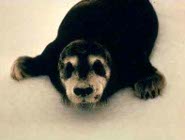 The Bearded Seal (Erignathus barbatus), with his dapper beard, is an aquatic mammal living in and around the Arctic Ocean. The scientific name of Erignathus barbatus, derived from the Greek words eri and gnathos, together mean "heavy jaw." It is also commonly referred to as the Square Flipper Seal. There are several distinguishing features of this breed of seal. It is earless, and the whiskers that make up the seal's beard curl up when dry, giving it a very debonair appearance. The muzzle is adorned with a set of very thick bristles, and the fore flippers are very square in shape, hence the common name often associated with this species. The pups, as baby seals are referred to, are born grayish-brown in color, with an intermittent pattern of white spots on the back and head. As they mature into adult seals, the overall fur color remains grayish-brown, but the fur darkens along the back, and the spots disappear. A few dark spots may develop along the flanks, as opposed to the white spots of the pups. The face and neck may often be reddish-brown in color. Another feature Bearded Seals possess is the presence of two pairs of nipples. This is uncommon in seals, and only Monk Seals share this characteristic.
The Bearded Seal (Erignathus barbatus), with his dapper beard, is an aquatic mammal living in and around the Arctic Ocean. The scientific name of Erignathus barbatus, derived from the Greek words eri and gnathos, together mean "heavy jaw." It is also commonly referred to as the Square Flipper Seal. There are several distinguishing features of this breed of seal. It is earless, and the whiskers that make up the seal's beard curl up when dry, giving it a very debonair appearance. The muzzle is adorned with a set of very thick bristles, and the fore flippers are very square in shape, hence the common name often associated with this species. The pups, as baby seals are referred to, are born grayish-brown in color, with an intermittent pattern of white spots on the back and head. As they mature into adult seals, the overall fur color remains grayish-brown, but the fur darkens along the back, and the spots disappear. A few dark spots may develop along the flanks, as opposed to the white spots of the pups. The face and neck may often be reddish-brown in color. Another feature Bearded Seals possess is the presence of two pairs of nipples. This is uncommon in seals, and only Monk Seals share this characteristic.The Bearded Seal's length is measured from nose to tail, and ranges from 7.4 to 8.9 ft, (2.25 to 2.
The Bearded Seal's diet consists of small prey living along the ocean floor. This includes clams, squid, and fish. Adult seals prefer not to dive too deeply for food, and tend to hunt in coastal waters with depths of 300 m or less. Pups are a little more daring, and will often dive as deep as 450 m for hunting. The fancy whiskers that adorn the Bearded Seal's face, are not only handsome, but serve as feelers when searching for food along the sediment of the ocean floor.
The Bearded Seal gives birth in the spring of each year to pups weighing around 30 to 40 kg. The pups are born on drifting ice floes in shallow waters, and then take to the water at only hours old. Not much time is needed for the pups to become skilled divers. The pups nurse for a time period of approximately 18 to 24 days, consuming an average of eight liters of milk per day! They gain around 3 kg per day, growing to a weight of roughly 100 kg by the time they are weaned. The Bearded Seal's primary predators are the Polar Bear and of course, man, specifically the Inuit people inhabiting this area. The seal's skin is very desirable as a cover for wooden boat frames, as it is very buoyant. As of 2008, a status review was completed under the Endangered Species Act, and Bearded Seals have not been categorized as an endangered species. The Bearded Seal maintains a delicate balance in his ecosystem as both a predator and as prey.
Picture of the bearded seal pup: can you see the square flippers?
Keywords: flipper , whisker , brown , white , tail
The Bearded seal is listed as Least Concern (LR/lc), lowest risk. Does not qualify for a more at risk category. Widespread and abundant taxa are included in this category, on the IUCN Red List of Threatened Species
Namings for the bearded seal
A young / baby of a bearded seal is called a 'pup'. The females are called 'cow' and males 'bull'. A bearded seal group is called a 'pod, colony, crash, flock, harem, bob, herd, rookery, team or hurd'.Some facts about the
Bearded seal
Adult weight : 373 kg (820.6 lbs)
Female maturity :1712 days
Male maturity : 2223 days
Gestation : 259 days
Weaning : 28 days
Litter size : 1
Litters per year : 1
Interval between litters : 608 days
Weight at birth : 35 kg (77 lbs)
Weight at weaning : 75.75 kg (166.65 lbs)

Custom Search